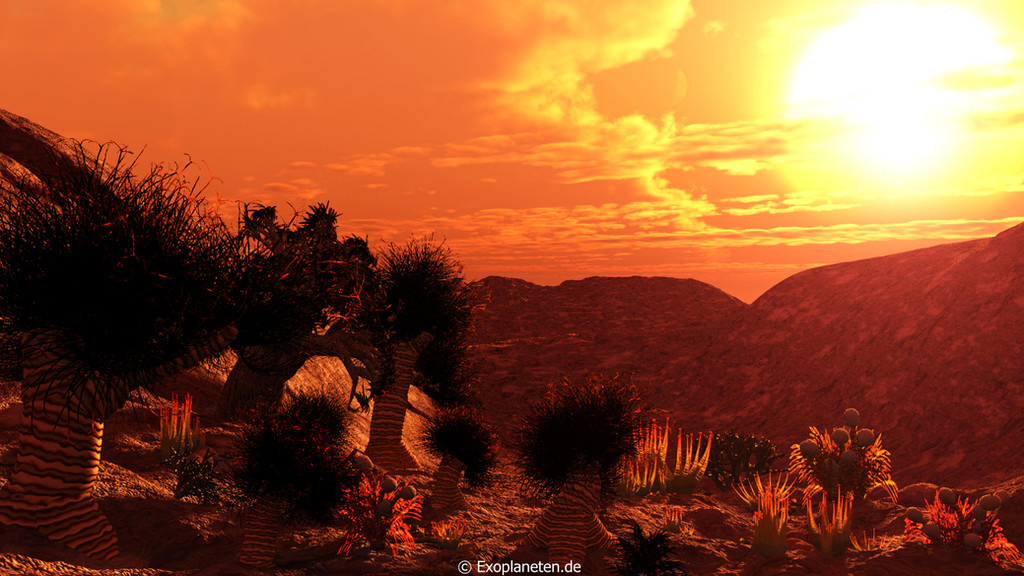HOME | DD
 ChrisKlm — Red Dwarf Planet Reworked - A Scenario for GJ667Cc
ChrisKlm — Red Dwarf Planet Reworked - A Scenario for GJ667Cc

#exoplanet #exoplanets #extraterrestrial #extraterrestrials #reddwarf #extraterrestriallife #reddwarfstar #extraterrestrialplanet
Published: 2016-03-02 11:03:42 +0000 UTC; Views: 3006; Favourites: 36; Downloads: 0
Redirect to original
Description
This is a sketch for a plausible scenario of life on a Red Dwarf planet.The planet GJ 667Cc was one of the first "Super-Earth" planets discovered within the habitable zone of it's parent star. The term "Super-Earth" means that it's mass is only a few Earth masses. It may be a larger and more massive analogue to Mercury, Venus, Earth or Mars. If this interpretation is correct, GJ 667Cc may be a rocky planet with a solid surface and some kind of atmosphere. But here the similarities to Earth come to an end.
The planet's parent star is a Red Dwarf, which in turn is part of a triple star system. The star is much smaller, dimmer and colder than our own sun and it's light is highly redshifted. This "Super-Earth" is so close to it's sun that it's rotation has long since come to an end. Only one hemisphere receives sunlight.
GJ 667Cc is located near the inner edge of the star's habitable zone and reveives about 90% of Earth's insolation. There is a chance that liquid water exists on it's surface, but if there were life on this planet, it had to cope with the different quality of the sunlight. If photosynthetic life evolved on that world, it would have to use red and infrared light, as this is the main light the star provides. Plants on this world may be black in appearance instead of the green we are used to, in a desperate attempt to absorb every available photon for photosynthesis.
With a minimum of 4-5 Earth masses, GJ 667Cc may have a much denser atmosphere than Earth. The constant insolation of only one hemisphere would give rise to frequent storms which would be more destructive than on Earth, as the moving denser air would impose more drag and friction upon the surface and any objects on it. The best places to live on this world would be wind-shielded areas, as featured in the scene above.
Red Dwarf stars are very interesting subjects for astrobiologists, as they burn their hydrogen much slower than our own sun does. Some of them will shine on the main sequence of stellar evolution for 500 billion (5 * 10^11) years or even longer, providing stable conditions for potential life on their planets much longer than any other kind of star.
But the small community in the scene above will not have that much time. Instead, it does not even have a long and prosperous future. The sun is close to the horizon and though daylight is eternal on the timescale of an individual plant, the continent on which this community is located will drift slowly into the dark hemisphere, into the realm of eternal night. Once there, any photosynthetic life in the area will become extinct, maybe giving place to new life forms....
For more information about GJ 667Cc, I suggest the following scientific paper:
iopscience.iop.org/2041-8205/7…
arxiv.org/pdf/1202.0446
This scene is based on Nancy Kiang's paper about the colours of photosynthesis:
online.liebertpub.com/doi/abs/…
arxiv.org/pdf/astro-ph/0701382
online.liebertpub.com/doi/abs/…
arxiv.org/pdf/astro-ph/0701391
Related content
Comments: 9

I assume that plants on red dwarf planets would be optimised to absorb low frequency visible light at the expense of high frequency light, since red dwarfs don't release much blue light. So yes, they'd look black on the red dwarf planet, but under our sun, I assume they'd look bluish.
If insolation is similar to that of Earth's, then the amount of usable light that reaches the surface should be less than Earths, but not too much. So plants wouldn't really look black under the full spectrum, probably. Most Earth plants adapted to low light don't look black.
Very nice image, it boggles the mind how different things can look on other planets. It's fascinating to imagine
👍: 0 ⏩: 0

I like how much detail you've put in this. BTW though, why would the plants need to be black to photosynthesize from a red-shifted light spectrum?
👍: 0 ⏩: 1

Thank you.
Under red dwarf conditions, only few energy-rich, shorth-length photons are available. If we assume the local vegetation absorbs all of them for photosynthesis, but still needs the red, poorer in energy photons in order to be effective, then there would be little left to be reflected in visible light.
Furthermore, if the local vegetations uses near-infrared photons as well, the best way to absorb these would be a black surface.
Of course it is also possible that leaves will develop different colours, for example in order to hide or to get attention, like flowers.
👍: 0 ⏩: 0

Thank you 
I try to make my scenes reasonable.
👍: 0 ⏩: 0

Its interesting to speculate what things might be like on known exoplanets. A tidally locked red dwarf world would certainly be an unusual place to our own perspective.
👍: 0 ⏩: 1

Yes, indeed. I try to make the plants look organic and grown under local conditions, responsive to their environment. Unfortunately, most terrestrial planets around red dwarf stars, which have formed in their life-friendly zones, have a high chance of being dry and airless deserts. So the scene above may already represent an exception.
👍: 0 ⏩: 0



























